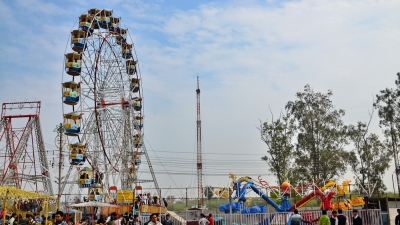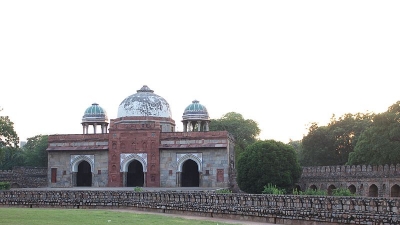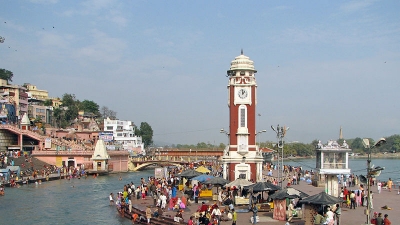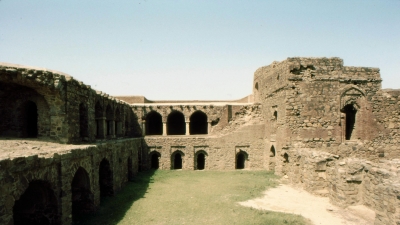Jind Attractions - Tourist Places To Visit In Jind
-
01Dhamtan Sahib Gurudwara
 + Read More
+ Read MoreThe word “sahib” is normally used with gurudwaras, the temples of the Sikhs. But, the reason why it has been used with a village is because Dhamtan is a religious and historical place. The name Dhamtan is also considered a corruption of the word “dharamsthan” meaning “religious place”.
Village Dhamtan Sahib is primarily a Jat stronghold and is situated 17 kilometres from Narwana Tehsil in Jind district. The village is home to an ancient Shiva temple and an ashram of Rishi Valmiki, the creator of the epic Ramayan. It is also believed that Lord Ram conducted the Ashwamedha Yagna at this place.
Guru Teg Bahadur, the ninth guru of the Sikhs, is also believed to have stayed here on his journey to Delhi. A fort like gurudwara in a 500 acre area gifted by the locals to the Guru was built to commemorate the visit of the guru. There is also another gurudwara in the village named Manji Sahib.
-
02Bhuteshvara Temple
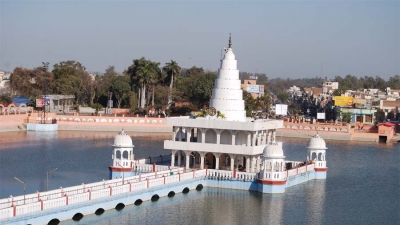 + Read More
+ Read MoreBhuteshwar Temple is called so because it is dedicated to Lord Shiva who is also called Bhootnath, the lord of the bhoots, ghosts or spirits. This explains why almost all the crematoria in North India are adorned with huge idols of Lord Shiva. When a person dies and he is cremated, what is left is his spirit.
The temple is situated on Gohana road. It was built by Raja Raghbir Singh, the ruler of Jind. It is built on the pattern of the Golden Temple of Amritsar since it is surrounded by a huge water tank or talaab. Therefore, it is also called Rani Talaab.
One reason for building the tank was for the queen to take a bath in it. The king, therefore, built a tunnel connecting the tank with the palace so that Her Majesty could access it without being exposed to public view. The remnants of the tunnel are still visible. The temple houses the idols of several other gods and goddesses. It is also known as the pool of the royal family of the state of Jind.
-
03Jayanti Devi Temple
 + Read More
+ Read MoreJayanti Devi Temple was built some 550 years back in reverence to the wishes of the daughter of the ruler of Kangra, in Himachal Pradesh, who was married to one of the sons of the ruler of Hathnaur, located in the north of Chandigarh. The princess was an ardent devotee of Jayanti Devi, the goddess of their clan.
She was worried that she would be deprived of the worship of the goddess after her marriage in the absence of the temple. She, therefore, prayed hard to the goddess for help.
It is said that the doli (palanquin) carrying her became so heavy that its bearers could not move further. Seeing this predicament, a small idol of the goddess was placed inside the doli and the problem was resolved.
The ruler of Hathnaur, therefore, built a temple dedicated to Goddess Jayanti Devi at a hillock in the Shivalik ranges, 15 kilometres from Chandigarh.
The village Jayanti Majri and Jayanti Archeological Museum located at the foot of the hill and a seasonal stream, Jayanti Rao, flowing close by owe their names to the temple which can be reached after climbing a hundred steps.
-
04Ramrai
 + Read More
+ Read MoreRamrai or Ramray, a Jat dominated village, is located on the Jind-Hansi road 8 kilometres in the western side of district Jind. The village owes its name to Ramahrada, a pool built by the ever-angry warrior-sage Lord Parasurama.
According to the Vamana Purana, which identifies Ramahrada with the village Ramrai located near Jind, Lord Parasurama killed so many Kshatriyas or Haihayas that he filled five pools with their blood to propitiate his ancestors. The blood flowed into the pools like water. It is, therefore, believed that a bath in the pool at the Ramahrada Temple is very holy and brings in a lot of religious merit.
An ancient temple dedicated to Lord Parasurama is located nearby. The idol in the shrine is worshipped regularly. Ramrai is an ancient village and is popular religious destination for the people in the surrounding areas who flock to it in large numbers all through the year.
-
05Hansdehar
 + Read More
+ Read MoreThe district of Jind, a Puranic city, is extensively dotted with a host of cities, towns and villages of the ancient era. Most of these habitats owe their names and origin to mythological times and are mentioned in scriptures. The village Hansdehar, situated in Narwana Tehsil in Jind, is one of them.
The name of the village comes from an anecdote which says that Lord Brahma came here on his bird, hans (goose) to participate in the marriage of Rishi Kardam. It is believed that Hansdehar was the birthplace of Rishi Kardam and that he performed tapasya (meditation) at this place for several years.
It is also believed that the sacred river Saraswati flowed by the village and that the Pandav brothers performed the rituals of offering pind daan to their ancestors here. The village is also a home to a temple dedicated to Lord Shiva and Bindusar Tirtha.
-
06Hazrat Gaibi Sahib
 + Read More
+ Read MoreThe district of Jind with its satellite towns, cities and villages is situated amongst the most ancient habitats in the state of Haryana. Their names and origins can be traced to Puranic times.
The district is not only a proud home to ancient religious, cultural places, personalities and monuments of the Hindus, but of Muslims as well. One of these monuments, a tomb, is dedicated to Hazrat Gaibi Sahib situated in Narwana Tehsil in the district of Jind.
The tomb houses the remains of a great sufi saint, Hazrat Gaibi Sahib. He was an extremely spiritual and pious person. Sufi saints are known to possess supernatural powers and Hazrat Gaibi Sahib was no exception. It is said that he just miraculously disappeared into the ground. The tomb is surrounded by a beautiful tank where the devout wash their hands and feet before offering their prayers.
-
07Safidon
 + Read More
+ Read MoreSafidon is a tehsil headquarter in the district of Jind. It is located some 35 kilometres from Jind on the Hansi Branch of Western Yamuna Canal. It can also be accessed through the Panipat-Jind railway line. Safidon, like most other cities, towns and villages of the region boasts its origin and relationship to prehistoric times.
According to scriptures, Safidon was called Sarpadevi or Sarpidadhi, which is mentioned in Mahabharata. It is also mentioned that Parikshit was killed during a battle with Nagas of Taxiles and that Janmejaya avenged the death of his father by defeating the Nagas. Following the epic traditions of Sarapasastra, he performed a snake sacrifice at the spot called Sarpadevi, which is the present day Safidon.
The town is home to three prehistoric pilgrimage centres and temples of Nageshwar Mahadev, Nagadamni Devi and Nagashetra. Historians have recovered pottery pieces of ancient times from the excavations conducted in this region. It has been revealed that the area was captured by an agricultural community of pre-Harappan Chalcolithic times.
-
08Ekahamsa
 + Read More
+ Read MoreThe word “hamsa” in the title refers to the migratory bird “swan” or “goose”, which according to Hindu-Buddhist views is the vehicle or the ride of Goddess Saraswati. The reason why the goddess chose this bird is that it can fly non-stop for whopping 7,000 miles over great heights.
The swan is a bar-headed bird that resides in Mansarovar Lake in Tibet and flies over thousands of miles to migrate to Indian habitats during winter. According to Upanishads, the swan eats only pearls and can segregate milk from water if both are mixed together. Moreover, it possesses the holy knowledge of the Brahma.
The sacred land of Jind has deep roots in mythology. This explains the existence of Ekahamsa Temple in the village of Ikkas about five miles from Jind. It can be accessed through Jind-Hansi road.
The shrine is also mentioned in epics which relate to Lord Krishna. The temple also has a painting portraying how the lord showers his love on one and all.
-
09Asvini Kumara
 + Read More
+ Read MoreAccording to Rig Veda, the twin deities called Ashvins are regarded as the most important gods next only to Indra, Soma and Agni. There are three important reasons for their greatness.
One, they are strong votaries of truth and fierce opponents of falsehood. Two, they are always up on the horses. Three, they are excellent physicians. They are, in fact, the doctors of gods. Whenever gods feel indisposed, they at once rush to Ashvins for medical assistance. They also bestow their kindness on the ordinary human beings on earth especially with respect to healing their incurable diseases.
A shrine dedicated to Asvini Kumars exists in Jind. It is located around 14 kilometres in the eastern side of the city. The holy place is also mentioned in Mahabharata, Padma Purana, Naradiya Purana and Vamana Purana.
According to scriptures, a bath in the sacred waters of Asvini Kumara can purify the soul of the pilgrims and open way to their salvation. The water at the holy place has curative properties and can heal several incurable diseases. The shrine houses charming idols of two gods who are worshipped with deep reverence.
-
10Varaha
+ Read MoreVaraha is a Sanskrit language word; it means boar. According to scriptures, it is one of the ten main incarnations of Lord Vishnu that he took to protect his devotees from misfortunes.
It is said that the demon Hiranyakashipu stole earth, represented in the human form by Goddess Bhudevi. He concealed it in the ocean. Seeing this predicament, Lord Vishnu appeared in the form of a boar and rescued earth from the ocean. The idol of Varaha is often represented with the head of boar and the body of a human being.
A shrine called Varaha Tirtha dedicated to Lord Vishnu is situated in village Barah, ten kilometres from the main town of Jind. It is believed that Lord Vishnu stayed at this place when he assumed the form of a boar.
Therefore, a bath in the shrine pool provides blessings of Lord Vishnu. If somebody stays here, he collects religious merit equal to Agnistoma. Agnistoma is a prayer to the fire god and is performed for days together and culminates with the sacrifice of an animal.
-
11Munjavata
 + Read More
+ Read MoreMunjavata Tirath is located at village Nirjan, which is six kilometres from Jind. According to Vamana Purana, the holy place is associated with Mahadev, the lord of gods. Lord Mahadeva is also known by various names one of which is Mrityunjaya, or the conqueror of death. Therefore, he is also called Mahakala.
He has a third eye on his forehead. His right hand is held in an intimidating gesture and he holds a trident with a damru tied upon it in his left hand. He wears the skin of a tiger and he also sits on the tiger skin. He carries a kamandal filled with sacred water.
It is, therefore, rightly believed that a fast and a prayer at Mujavata bring in the grace of God and everlasting peace and bliss. A night's fast at Munjavata can help one achieve Ganapatya, which is regarded as the abode of Ganesa.
-
12Yakshini
+ Read MoreYakshas and Yakshinis are gods and goddesses. They hold a place of special importance in Jain religion. According to Jainism, they were appointed by God Indra, the lord of heaven, to protect the Jain Tirthankars. That is why Yakshinis are also called protective deities. They are always positioned in such a way in the Jain paintings or sculptures that a Yaksha is on the right side of the Jin and Yakshini on the left side.
According to Jains, the Jins, too, are human beings and as such are susceptible to human failings. The Yakshas and Yakshinis accompanying them always remind them of their duties and goals.
A temple dedicated to Yakshini Mahagrahi is located in the village Dhanikhera, 8 kilometres from Jind. The shrine is situated close to Manjuvata. According to scriptures, a bath in the shrine accompanied by fasting propitiates the goddess and consecrates the devotees of all their sins. It also fulfils all the wishes of the visitors.
-
13Pushkara
 + Read More
+ Read MoreThe shrine of Pushkara is located in village Ponkar Kheri, which is twenty kilometres south of Jind. It was set up by Parasurama, the son of Jamadagni and Renuka, whose reference is found in Puranic scriptures. He was the disciple of Shiva. His family lineage descended from Brahma.
Parasurama is regarded as the sixth incarnation of Lord Vishnu and was blessed with immortality. It is believed that he performed long and severe penance to propitiate Shiva. Pleased by his devotion, Shiva taught him martial arts and gifted him an axe.
It is said that his father was killed by a Kshatriya king, Kartavirya, which enraged Parasurama so much that he avenged the death of his father by killing Kshatriyas twenty one times.
He also taught martial arts to Karna and Dronacharya of Mahabharata. He was the founder of several Brahmin dynasties. According to tradition, a prayer in this temple is returned with merit of performing Asvamedha sacrifice. Offering prayer to one's ancestors is considered quite pious and holy.
-
14Kayasodhana
+ Read MoreThe word “kayasodhana” is formed of two words, “kaya” and “sodhana”. While “kaya” means “body”, “sodhana” means “cleansing, detoxification or purification of the body of all the impurities or toxins”. The process of Kayasodhana takes three major steps.
The first step is, of course, detoxification. It uses a combination of yogic and naturopathic measures. Each person requires special techniques for detoxification depending on individual constitution, though there are some common practices that are applicable to everyone.
The second step aims at rejuvenating the body after it has been purified of toxins and wastes. The aim is to prepare the body so that all its organs work in perfect co-ordination with each other.
The third and the final step is nutrition. The patient is administered a proper dietary regime that suits his personal physical requirements. The diet comprises a mixture of fruits, vegetables and drinks.
The shrine of Kayasodhana is located at Kasohan, is 16 kilometres to the north of Jind. According to Puranic traditions, Lord Vishnu created Kayasodhana by taking a bath at this place.
-
15Sri Tirtha
 + Read More
+ Read MoreSri Tirtha or the pilgrim centre houses a salagrama, a precious stone generally of black colour. The true salagramas are fossilised stones and are found in Gandaki river in Nepal and in some regions of the Himalaya mountains. They are spherical, shaped like discus.
Salagrama stones are regarded sacred and are, therefore, used to make idols. They resemble the Sudarshan Chakra, the weapon used by Lord Krishna or Vishnu to kill the demons.
A salagrama stone, therefore, represents Lord Vishnu himself. It is believed that the worship of salagrama pleases Lord Vishnu who blesses the devotees with health, wealth, wisdom and happiness. The worship involves pouring water over the statue, collecting it in a bowl and drinking it. The water is transformed into holy nectar and acquires divine qualities.
Sri Tirtha is located at the Simla village in Narwana Tehsil of Jind district. It is regarded as the supreme place of worship. There is a holy pond close by and a bath in it provides eternal peace and happiness to the devotee.



 Click it and Unblock the Notifications
Click it and Unblock the Notifications



